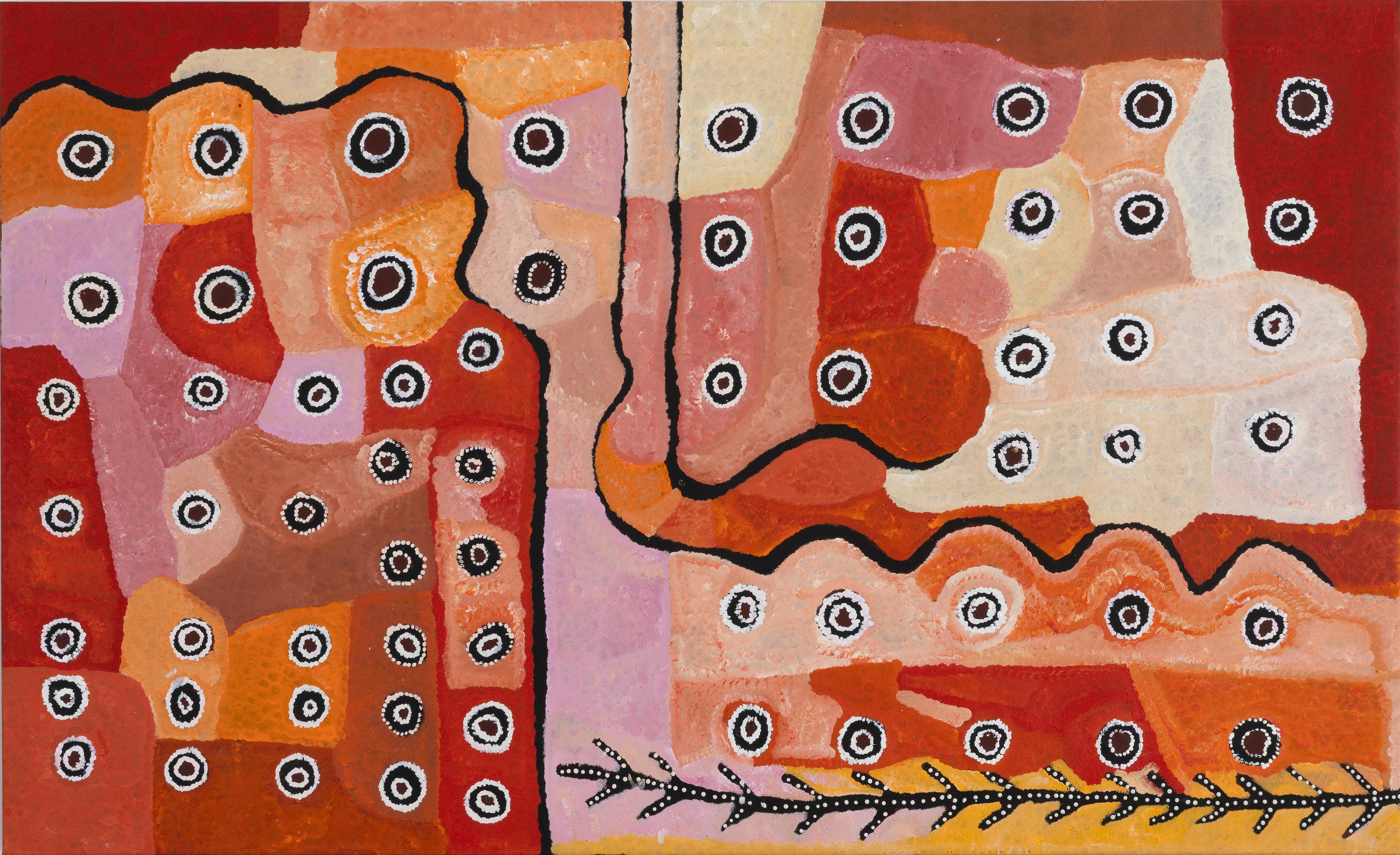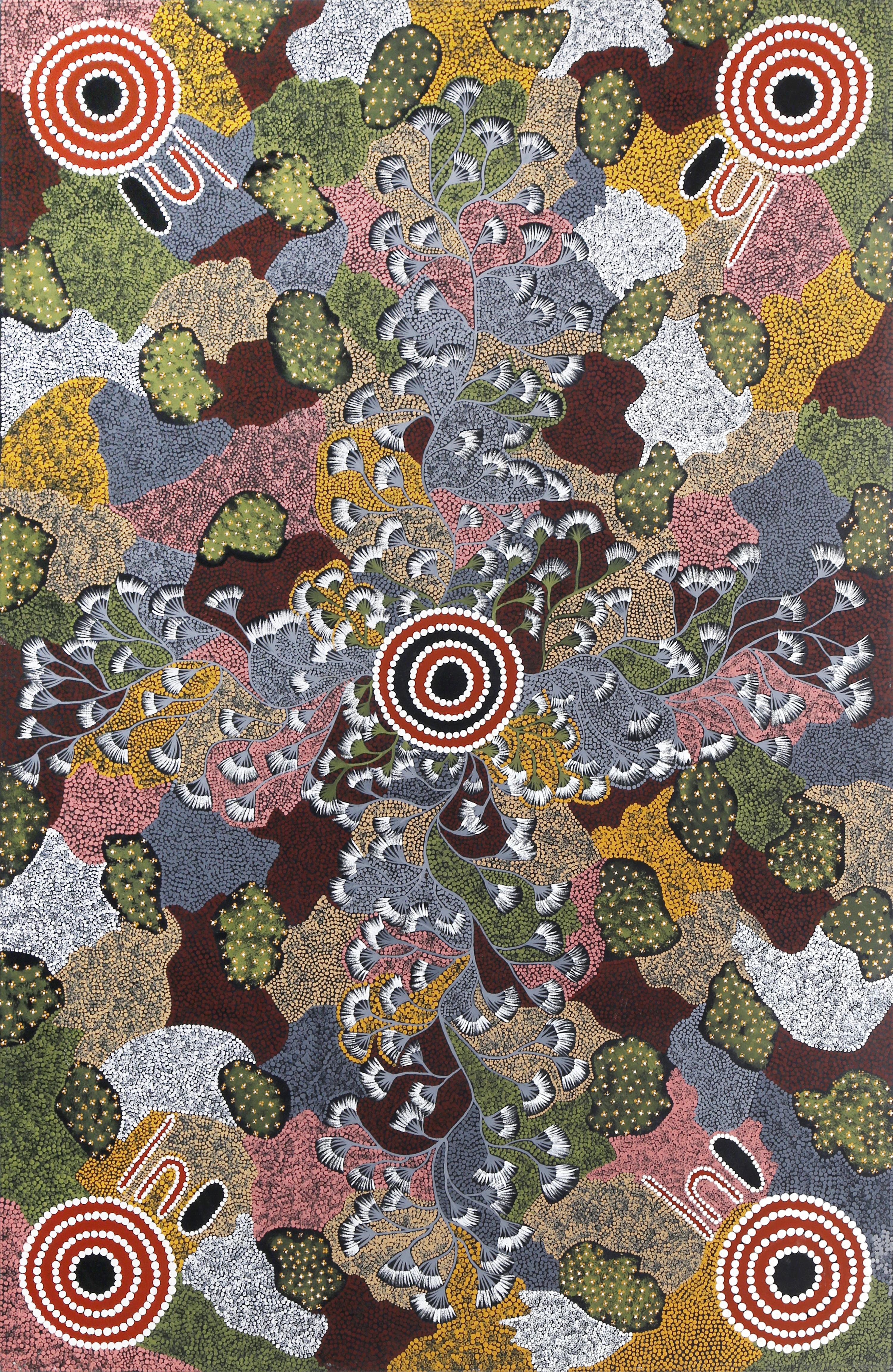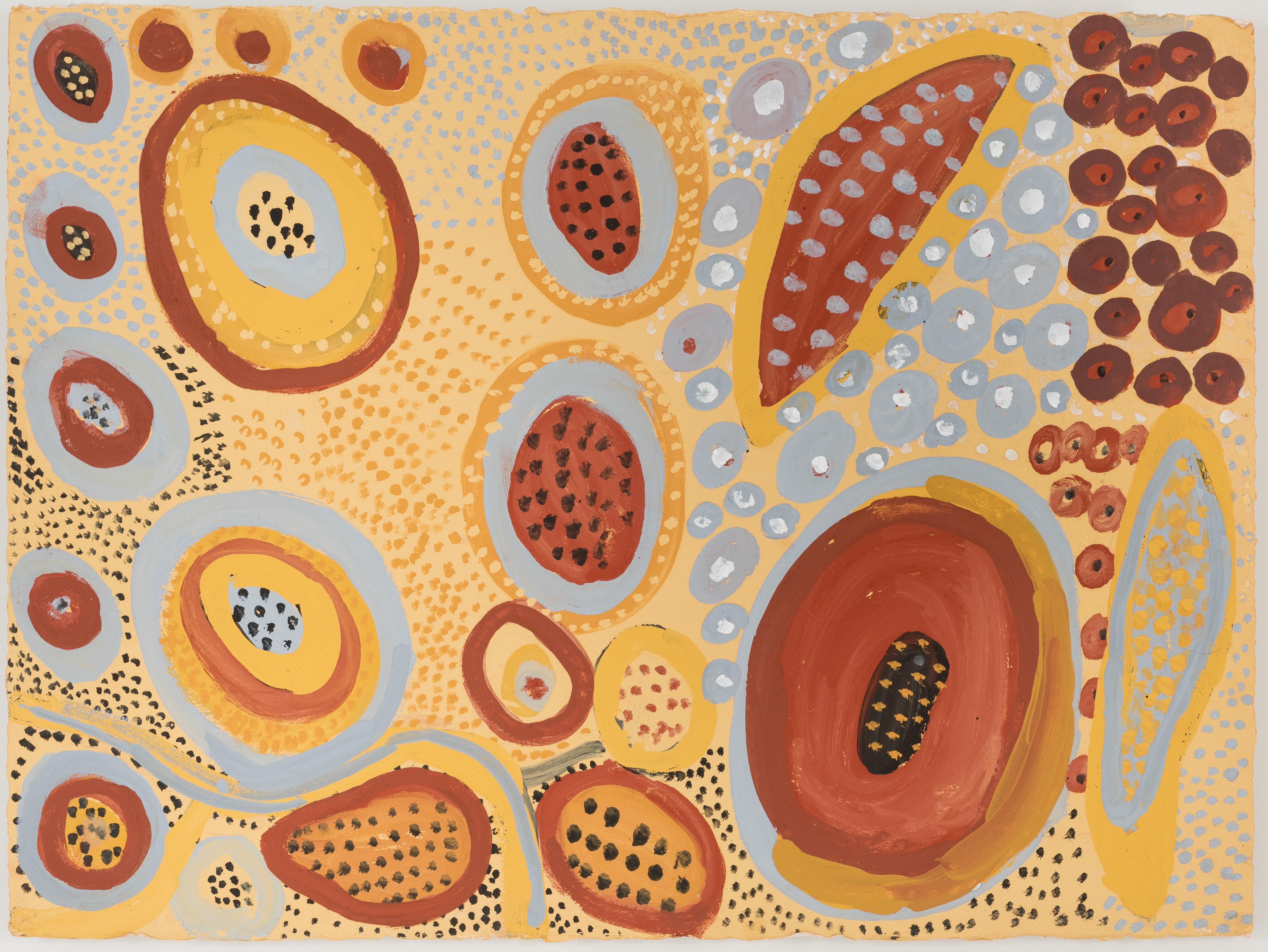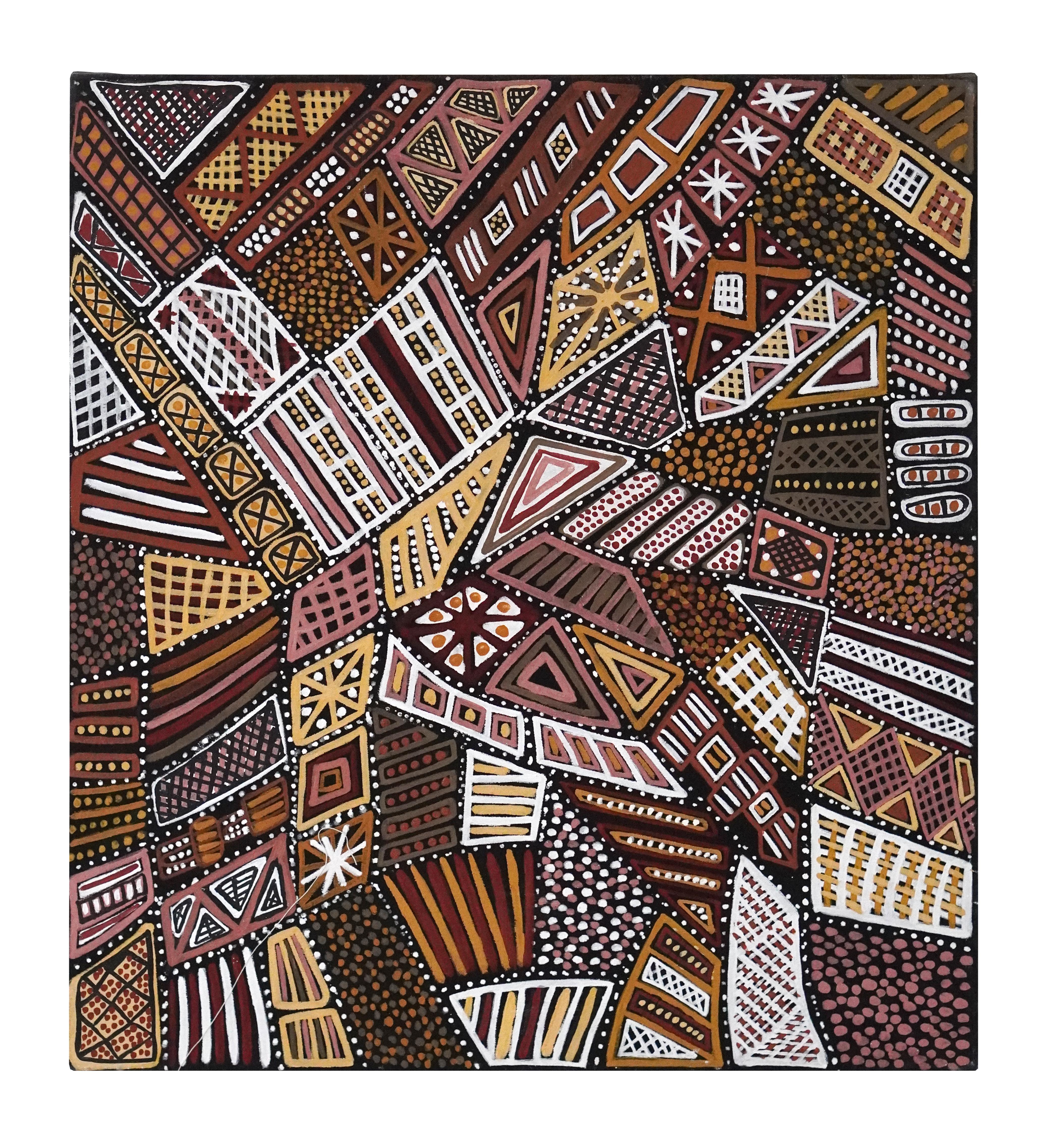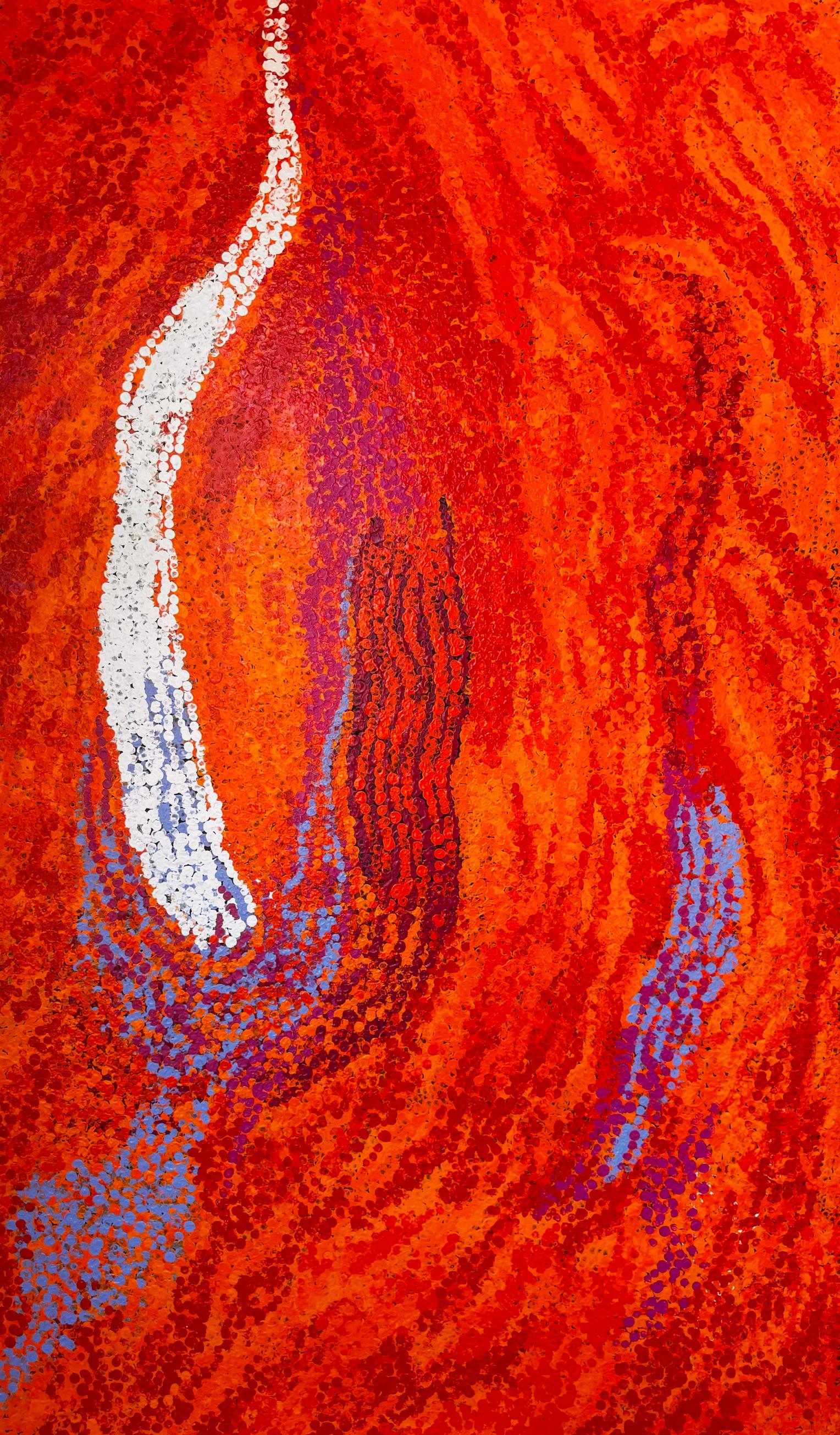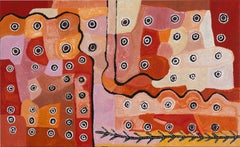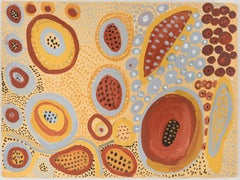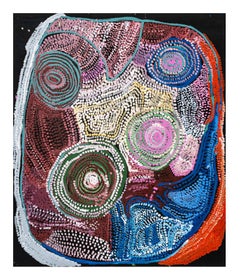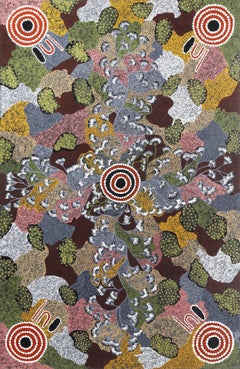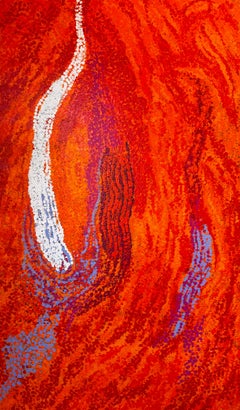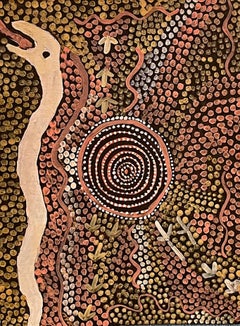Items Similar to Yariny Daam (Moon Dreaming Country)
Want more images or videos?
Request additional images or videos from the seller
1 of 12
Rusty PetersYariny Daam (Moon Dreaming Country)2015
2015
$4,613.52
£3,360
€3,925.58
CA$6,406.40
A$6,990.87
CHF 3,666.83
MX$84,906.48
NOK 45,800.73
SEK 43,283.98
DKK 29,299.05
About the Item
Rusty Peters (1935-2020) was a senior Gija man, born in Darrajayin (Springvale Station), Western Australia. Peters grew up learning traditional Gija law and worked as a stockman on Springvale station. After the death of his father, he moved to Mabel Downs where he worked as a horse breaker. In 1968, following the introduction of award wages for Indigenous people working on pastoral property, Peters was forced to move off Mabel Downs station and began living at Nine Mile reserve, 130 miles from Warmun/Turkey Creek. Prior to the introduction of these wages, Indigenous workers were only paid in rations. He started working at Warmun Art Centre in 2010, twelve years after the art centre opened, and continued to do so until his passing in 2020. One of the main Ngarranggarni of Warmun artists is Garnkiny Ngarranggarni, often painted in Mabel Juli’s (Peters’ sister by kinship)
symbolic Moon and Stars paintings.
In Yariny Daam (Moon Dreaming Country), Peters paints part of the story of Garnkiny (Moon) Ngarranggarni, in a one point-perspective depiction of the landscape of his Country. While using geographical features to tell the story, the earth becomes symbolic of Ngarranggarni. In this image, Peters paints a clouded grey sky, above an open brown landscape with hills of varying elevation. The hills in the background refer to the hill that Garnkiny climbed when he was angry at his community and transformed into the moon. The moon is not present, which alludes to the days when Garnkiny rests. At the base of the image, we see mawoondool (white clay) dot work in eleven circle formations. These suggest the ancestral power of the landscape. The white dot work contrasts with the muted tones of Yariny Daam (Moon Dreaming Country) and illuminates the landscape, like constellations in the night sky. There is almost a spiritual presence in this image from the white dots, alluding to the mob that stood below the hill, watching Garnkiny as he turned into the moon while he rejoiced at the thought of their bones turning white in the sand as they die.
The story and painting also have a social application. Garnkiny’s desires lead to his shameful exile, while the retelling of the story tells of social mores; how to behave and how not to. The Garnkiny Ngarranggarni is more than a story, it expands on the principles of Gija law and reflects on the human experience, social structures, and the natural world. It has layered meanings “of kinship and the orderly management of marriage in society, human mortality the power of illicit sexual desire and the ecological and personal relationships of the Gija with their land still resonates with the people today” (Warmun Art Centre, 2014). There’s this tension between a very old story, painted in the landscape as it stands now, resisting the passing of time. The white dots are an abstraction of people who once stood there; it’s almost as if Peters is looking at the landscape as it is now, on a cloudy night, and remembering the story.
- Creator:Rusty Peters (1935 - 2020, Aboriginal Australian)
- Creation Year:2015
- Dimensions:Height: 39.38 in (100 cm)Width: 39.38 in (100 cm)Depth: 2.37 in (6 cm)
- Medium:
- Movement & Style:
- Period:
- Condition:
- Gallery Location:London, GB
- Reference Number:Seller: 24921stDibs: LU1868215089852
About the Seller
No Reviews Yet
Vetted Professional Seller
Every seller passes strict standards for authenticity and reliability
Established in 2017
1stDibs seller since 2022
5 sales on 1stDibs
- ShippingRetrieving quote...Shipping from: London, United Kingdom
- Return Policy
Authenticity Guarantee
In the unlikely event there’s an issue with an item’s authenticity, contact us within 1 year for a full refund. DetailsMoney-Back Guarantee
If your item is not as described, is damaged in transit, or does not arrive, contact us within 7 days for a full refund. Details24-Hour Cancellation
You have a 24-hour grace period in which to reconsider your purchase, with no questions asked.Vetted Professional Sellers
Our world-class sellers must adhere to strict standards for service and quality, maintaining the integrity of our listings.Price-Match Guarantee
If you find that a seller listed the same item for a lower price elsewhere, we’ll match it.Trusted Global Delivery
Our best-in-class carrier network provides specialized shipping options worldwide, including custom delivery.More From This Seller
View AllNgura (Country)
Located in London, GB
Eric Barney Kumanara grew up in Indulkana Community where he continues to live and work. Working with Iwantja Art Centre since 2008, Barney has been guided and mentored on painting t...
Category
2010s Abstract Abstract Paintings
Materials
Linen, Acrylic
Aru (Rocks)
By Mary Umagari Teresa Tailor
Located in London, GB
Mary Umagari Teresa Tailor was born in Wyndham and grew up in Oombulgurri (Forrest River). She learned painting from the old people by watching their ground paintings and painted for...
Category
2010s Abstract Landscape Paintings
Materials
Pigment
Pupuni Jilamara
Located in London, GB
“Hi my name is Shirley I was Born on Bathurst Island,' since then I grow up older at the age of 16 years and then went to school call s.t.s. on Bathurst Island back in1985, 1986 and ...
Category
2010s Contemporary Abstract Paintings
Materials
Canvas, Organic Material
Warmurrungu
By Nyarapayi Giles
Located in London, GB
Nyarapayi Giles, a Ngaanyatjarra woman, began painting on canvas while settled in Patjarr Community, when the modern Desert Art Movement sprung from Papunya Tula and gained astoundin...
Category
2010s Contemporary Landscape Paintings
Materials
Acrylic
Dreaming
Located in London, GB
George Cooley is a senior man and community leader from Coober Pedy. He holds leadership positions across the Umoona and Coober Pedy communities and is a talented artist and opal min...
Category
2010s Contemporary Landscape Paintings
Materials
Canvas, Acrylic
$7,826
'Antara', an acrylic and ink painting on linen by Puna Yanima.
Located in London, GB
Puna Yanima was born in the bush, close to DeRose Hill Station in the far north of South Australia.
Puna continues to be one of the senior cultural leaders of Mimili Community. She ...
Category
2010s Contemporary Abstract Paintings
Materials
Linen, Ink, Acrylic
You May Also Like
Australian Aboriginal Painting by Kathleen Petyarre with Provenance
By Kathleen Petyarre
Located in Atlanta, GA
A contemporary aboriginal painting by Kathleen Petyarre (1940-2018). The highly collectible painting was from 2012. It is stretched (no frame but ready to hang) and comes with a copy...
Category
2010s Australian Modern Paintings
Materials
Canvas, Acrylic, Wood
Western Macdonnel Ranges
By Dorothy Napangardi
Located in Long Island City, NY
Dorothy Napangardi was one of the leading Australian Aboriginal artists who has had her work hung at museums around the world. On the verso of this ...
Category
1970s Abstract Expressionist Abstract Paintings
Materials
Canvas, Oil
Price Upon Request
Ngayuku Kgura (My Country)
By Yannima Tommy Watson
Located in Miami, FL
Yannima Tommy Watson is a Pitjantjatjara artist born around the 1930s, in the bush some 44km west of the small isolated community of Irrunytju. Not yet very well known to the French public, despite his participation in the architectural project of the Musée du Quai Branly, Tommy Watson is nevertheless often considered the greatest living Aboriginal artist.
Like many aborigines of his generation, he lived a traditional, nomadic or semi-nomadic life before his contact with Western civilization; then he will occupy the only jobs that the Aborigines find: herdsmen (until Yuendumu), laborers for the construction of infrastructures in the desert. Throughout this period he became familiar with his "country", a harsh region, and deepened his knowledge, both profane and sacred, relating to Dreams and Dreamtimes, to the connections between sacred sites and the Ancestors. He will even work in Papunya, where the artistic movement started. But the Pijantjarra are intransigent with tradition…no question at this time of revealing the motives and the secret stories.
The North of South Australia, the region where he is from, was touched by the pictorial movement only at the very beginning of the 2000s. In 2001, Tommy began his career as an artist in Irrunytju (Wingellina). He is a young artist… He learns by observing other painters and draws on the experiences of a long life and on the exceptional knowledge he has stored up. But quickly he will find his way, a radically new style where color plays a major role. Very quickly, the iconography now well known by the artists of Yuendumu, or the Western Desert, Balgo or Lajamanu disappeared. The symbols are no longer there. As Rover Thomas, Emily Kame or Paddy Bedford had done before him, this is a real artistic revolution. For Tommy, it is not a question of describing his Dream (Caterpillar), the routes taken by the Ancestors. He concentrates on a site, a story, sometimes very profane, the memory of a meeting, of a hunting party, tries to condense his memories, the information of which he is the depositary, to add a poetic touch to it, sometimes melancholy, and this gives a painting with a very abstract aspect. It is a painting where the emotion is very present, undoubtedly less cerebral than the art of the neighbors of the north the Pintupi, like Ronnie Tjampitjinpa, George...
Category
2010s Contemporary Abstract Paintings
Materials
Linen, Cotton Canvas, Acrylic
Aboriginal painting on canvas board by Johnny Warangkula
Located in Miami, FL
Johnny Warangkula Tjupurrula
1925 - 2001
Born : Mintjilpirri, Kintore, NT
Language group : Pintupi/Warlpiri
Community : Papunya, NT
Johnny Warangkula Tjupurrula was born in 1925 at ...
Category
1970s Abstract Abstract Paintings
Materials
Cotton Canvas, Polymer
Yannima Tommy Watson "Ngayuku Ngura" - 91x122 cm -2013 - Aboriginal Art
By Yannima Tommy Watson
Located in PARIS, FR
Artist: Tommy Watson Yannima Pikarli (c.1935-2017)
size: 91x122cm
year: 2013
Acrylic on linen
Aboriginal Art
Provenance:
Yanda Art, Australia (certificat)
Aborigène Galerie Paris,...
Category
2010s Contemporary Abstract Paintings
Materials
Acrylic
As the Moon Rises
By Susan Hall
Located in Lyons, CO
Color lithograph with pochoir, Edition25
Susan Hall lived and worked for many years in New York City before returning to her childhood home in Point Reyes Station, California. She depicts moments suspended in the mysterious light of this place of marshland, wave-broken coast line and tawny, rolling hills.
In Susan's latest prints Solitary Oak and As the Moon Rises...
Category
21st Century and Contemporary Contemporary More Prints
Materials
Lithograph
More Ways To Browse
Newcomb Macklin Frame
Oil Painting Roman Landscape
Oil Stormy Landscape Painting
Peaceable Kingdom
Setting Sun Painting
Swedish Impressionist Paintings
Virginia Impressionist
Wales Landscape Oil
White Mountains Paintings
Antique British Landscape Paintings
Antique Gold Framed Paintings
Arcadian Landscape
Aspen Colorado Art
Bluebells Painting
De La Pena
Docked Boat Oil Painting
Impressionist Painting Dunes
Large British Landscape Painting
